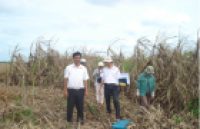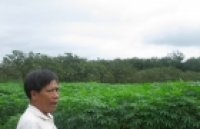| The sRNA NsiR4 is involved in nitrogen assimilation control in cyanobacteria by targeting glutamine synthetase inactivating factor IF7 |
|
A key enzyme in inorganic nitrogen assimilation, glutamine synthetase, is the target of multiple regulatory mechanisms. Here we describe the nitrogen stress-induced RNA 4 (NsiR4), a small regulatory RNA that reduces the expression of inactivating factor 7 (IF7), an inhibitory factor of glutamine synthetase in cyanobacteria. The expression of NsiR4 is under positive control through the nitrogen control transcription factor (NtcA). |
|
Stephan Klähn, Christoph Schaal, Jens Georg, Desirée Baumgartner, Gernot Knippen, Martin Hagemann, Alicia M. Muro-Pastor, and Wolfgang R. Hess SignificanceA key enzyme in inorganic nitrogen assimilation, glutamine synthetase, is the target of multiple regulatory mechanisms. Here we describe the nitrogen stress-induced RNA 4 (NsiR4), a small regulatory RNA that reduces the expression of inactivating factor 7 (IF7), an inhibitory factor of glutamine synthetase in cyanobacteria. The expression of NsiR4 is under positive control through the nitrogen control transcription factor (NtcA). NtcA also induces the transcription of the glutamine synthetase gene and represses the gene encoding IF7. Therefore, NsiR4 is a new player in the NtcA-mediated regulation of nitrogen assimilation, which is important for adaptations to rapid changes in available nitrogen sources and concentrations. Abstract
Glutamine synthetase (GS), a key enzyme in biological nitrogen assimilation, is regulated in multiple ways in response to varying nitrogen sources and levels. Here we show a small regulatory RNA, NsiR4 (nitrogen stress-induced RNA 4), which plays an important role in the regulation of GS in cyanobacteria. NsiR4 expression in the unicellular Synechocystis sp. PCC 6803 and in the filamentous, nitrogen-fixing Anabaena sp. PCC 7120 is stimulated through nitrogen limitation via NtcA, the global transcriptional regulator of genes involved in nitrogen metabolism. NsiR4 is widely conserved throughout the cyanobacterial phylum, suggesting a conserved function. In silico target prediction, transcriptome profiling on pulse overexpression, and site-directed mutagenesis experiments using a heterologous reporter system showed that NsiR4 interacts with the 5′UTR of gifA mRNA, which encodes glutamine synthetase inactivating factor (IF)7. In Synechocystis, we observed an inverse relationship between the levels of NsiR4 and the accumulation of IF7 in vivo. This NsiR4-dependent modulation of gifA (IF7) mRNA accumulation influenced the glutamine pool and thus
See: http://www.pnas.org/content/112/45/E6243.abstract.html?etoc PNAS November 11, 2015; vol. 112 no. 45: E6243–E6252
Fig. 3. Competitive growth analysis of WT and ΔnsiR4. (A) Experimental setup. Three independent, exponentially growing cultures of WT and ΔnsiR4 were diluted to an OD750 of 0.1 and mixed 1:1. (B) Growth performance during long-term cultivation. Cultures were rediluted every 3 or 4 d to an OD750 of 0.1 and 25 µL of a 1:1,000 dilution were dropped on BG11 agar plates with and without 40 µg/mL kanamycin. Data are the mean ± SD of WT and ΔnsiR4, as well as three mixed WT/ΔnsiR4 cocultures. Due to the lowered <mml:math><mml:mrow><mml:mi mathvariant="normal">N</mml:mi><mml:msubsup><mml:mi mathvariant="normal">O</mml:mi><mml:mn>3</mml:mn><mml:mo>−</mml:mo></mml:msubsup></mml:mrow></mml:math>NO3− content (1 mM instead of 17.6 mM <mml:math><mml:mrow><mml:mi mathvariant="normal">N</mml:mi><mml:msub><mml:mi mathvariant="normal">O</mml:mi><mml:mrow><mml:mn>3</mml:mn><mml:mo>−</mml:mo></mml:mrow></mml:msub></mml:mrow></mml:math>NO3−), a strong fluctuation in the cellular N status could be assumed, which was also indicated by the cultures switching between green or bleached appearance at lower (0.1–0.8) and higher (>0.8) ODs (see also C). (C) Whole cell absorption spectra of the WT culture indicating cellular bleaching, which was due to pigment degradation as response to initiated internal N limitation. (D) Number of generations that were observed over 50 d at average growth rates of µ = 0.751 ± 0.065. (E) Evolution of the ratio between kanamycin-resistant (ΔnsiR4) and total (WT + ΔnsiR4) colony forming units (CFUs) during consecutive cultivation and redilution. (F) Photographs of CFUs at the beginning of the experiment and after 33 and 48 generations (g). (G) Verification of the ΔnsiR4 mutant allele reduction (upper band) compared with the WT allele (lower band) by PCR. *To one of the WT/ΔnsiR4 cocultures once per day 100 µM NH4Cl (f.c.) was added to intensify the fluctuation in the N availability. However, no change in growth performance compared with the other two cocultures was observed. Thus, all three cocultures were averaged as shown in E. |
|
|
|
[ Tin tức liên quan ]___________________________________________________
|


 Curently online :
Curently online :
 Total visitors :
Total visitors :
(7).png)


